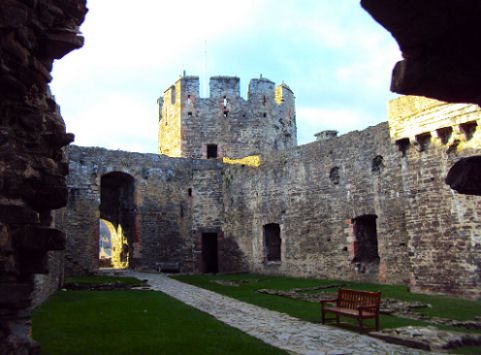Conwy Castle
OS grid ref:- SH 784 773.
Magnificent Conwy Castle, described as 'One of the great fortresses of medieval Europe', is without doubt one of the most impressive of Welsh castles.
The castle was was built on the site of an earlier Welsh monastery, founded by the Welsh prince Llewelyn Fawr. The present building was designed by the King Edward I's master architect-mason, James of St. George and was built between 1283-1289.
Conway Castle stands in a strategic position perched on a rock and dominates the Conwy estuary, on approach it conveys a deep sense of strength and impregnability. Conwy was one of King Edward I's most expensive projects and originally had a coat of whitewash.
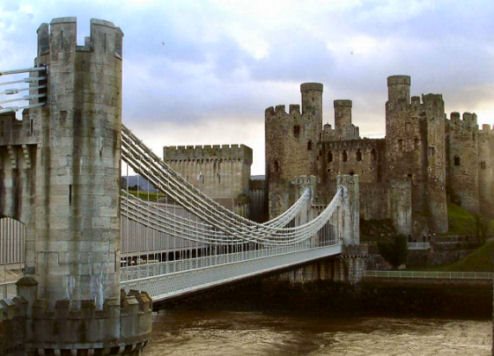
The castle provides the visitor with the opportunity of walking the top portions of the soaring curtain walls, from which the views over the town, its medieval walls and the estuary are stunning.
Conwy superficially resembles a concentric castle, but more accurately it is linear, and has eight towers and two barbicans, with walls which are 4.6 metres (fifteen feet) thick in places. The castle's shape was largely dictated by the rock on which it was built. The inner ward contains apartments built for King Edward I and his consort, Queen Eleanor of Castille in 1283. The interior of the castle is not as complete as Caernarfon. The huge towers measure over 9.1 metres (30 feet) in diameter with walls which are up to 4.6 metres (15 feet) thick. In height they total about 70 feet and contain several stories equipped with rooms and staircases.

Rebellion among the Welsh broke out in 1294 headed by Prince Madog, which resulted in the damage of a number of Edward's castles. He marched to Wales at the head of an English army to suppress the rebellion, where he set up his headquarters at Conway. Soon after he was esconsed inside the castle the River Conway flooded, trapping the English inside the castle for several days. Supplies of food and water became dangerously low before the water eventually receded.
Conway Castle degenerated into a state of disrepair within a generation of its completion. Repairs and modifications were carried out by Edward, the Black Prince, son of Edward III, in the fourteenth century.
The castle was besieged during the Welsh uprising of 1294. King Richard II stayed there on his return from Ireland in 1399, until lured out by the Earl of Northumberland acting on behalf of his cousin and rival for the throne, Henry of Bolingbroke. Northumberland swore in the castle chapel to grant Richard safe passage but went back on his oath and imprisoned him at Flint.
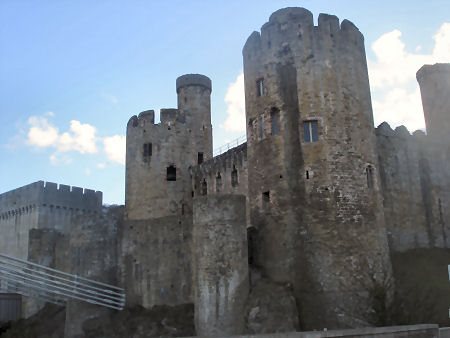
By the early seventeenth century the castle had fallen into such a state of disrepair that it was sold off in 1628 for a mere hundred pounds to Viscount Conway.
During the tumultuous period of the English Civil War, Conway was fortified and defended by the royalist Archbishop of York, but following a siege which lasted for three months, was taken by Cromwell's Roundheads.
The castle is now owned by CADW (The Welsh Historic Trust) Exhibits depicting life in the castle in the medieval period are regularly held. There is also a scale model of the castle and the town of Conwy on display in the chapel tower.
Following his conquest of Wales Edward I constructed a formidable Iron Ring of Castles, a days march from each other, to defend his aquisitions from Welsh rebellion.
Subsequent to Edward's first Welsh campaign when he succeeded in isolating his adversary, Llywelyn the Last in Snowdonia and Anglesey, the English king erected the castles of Flint, Rhuddlan, Builth Wells and Aberystwth.
After the failure of Llywelyn's second uprising in 1282, the Iron Ring was extended to include castles at Conwy, Caernarfon and Beaumaris.
Conwy Suspension Bridge, which crosses to the River Conwy to the castle, was built in 1826 by Thomas Telford, replacing a ferry that once operated at that point. The bridge was one of the world's first road suspension bridges, it may now only be crossed on foot and is managed by the National Trust. The bridge's supporting towers were designed to blend with the castle's turrets.
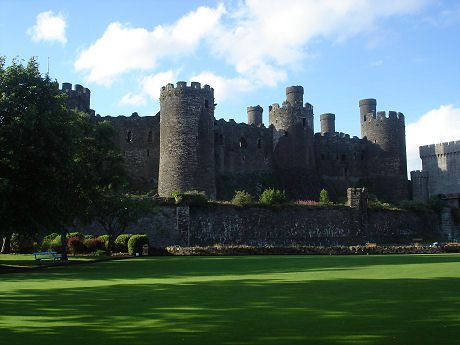
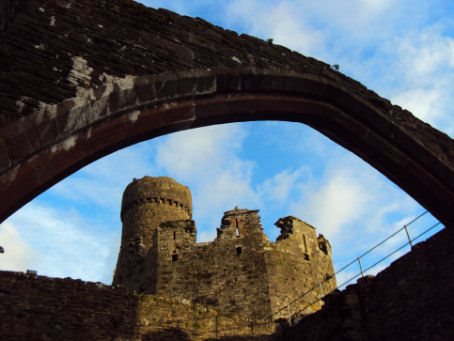
The wrought iron tubular railway bridge crossing the River Conwy from the castle was built by Robert Stephenson. The bridge was built into the rock on which the castle stands, part of the castle was demolished during construction in order for the suspension cables to be anchored into the surrounding rock.

